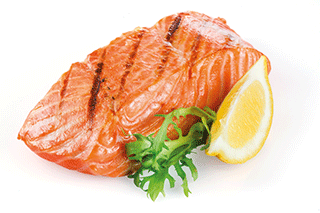Functional foods explained

What are functional foods, and should we be including them in our diets? Liz Parry finds out
The term ‘functional foods’ has begun to crop up more and more in recent times as healthy eating and natural wellbeing become increasingly popular. But what does this term actually mean?
According to registered dietitian and consultant nutritionist Hala El-Shafie, the term functional is used to “describe foods and drinks that are enriched with particular nutrients or substances that have the potential to positively influence health over and above their basic nutritional value”. They tend to be similar to foods that we might eat on a day-to-day basis, such as yogurt, cereals and bread.
Hala adds: “The British Nutrition Foundation advises that functional ingredients can be defined as a dietary ingredient that affects its host in a targeted manner so as to exert positive effects that justify certain health claims. In other words, foods containing these ingredients (functional foods) are foods that have health-promoting properties over and above their nutritional value.”
Functional foods can take many different forms, ranging from those which are formulated around a particular ingredient – such as stanol or sterol-enriched spreads or yogurts containing probiotic bacteria – to everyday foods fortified with a nutrient that would not usually be present to any great extent, such as folic acid-fortified bread.
The concept of fortifying foods is certainly not new, however. “Food fortification has been used historically to address many population-wide health concerns and we can see examples of successful food fortification programmes across the globe,” says wellness expert Shelley Cho (www.justsensiblehealth.com). “For example, in the 1920s fortifying sugar with iodine allowed for the prevention of goiter. Similarly, in the 1930s, milk was fortified with vitamin D to prevent rickets in children. Bread was also often fortified with B vitamins, when it was noted that populations were deficient in these micro-nutrients.
Even today food fortification is widely used in many countries both developed and developing, to improve the nutritional status of the population. For example, many developing countries have used food fortification programmes as a means of delivering cost-effective and easily accessible good nutrition to people across the population. It has been a popular means of nutritional intervention for vital micronutrients to be added to staple foods such as cereal flours, dairy products and cooking oils.”

Making a claim
“Health claims are often made about functional foods and legislation exists to protect consumers from misleading claims,” explains Hala. “A health claim is a claim made on food that states, suggests or implies that a relationship exists between a health benefit and a food category, a food or one of its constituents. It is important to assess each individual food on its own merit. In particular, it is crucial that robust science exists to underpin the claims being made. Typically this will include evidence that the substance is absorbed or reaches its site of action; that consumption of the food beneficially influences a physiological function in humans (e.g. blood pressure) or a biomarker recognised to impact on health (e.g. blood cholesterol) and, ideally, that this effect has a direct impact on health status.”
Here are some examples of functional foods:
Prebiotics
“The term ‘prebiotic’ was first coined pretty recently in 1995 and can be defined as ‘a non-digestible food ingredient that can deliver beneficial effects on health by selectively stimulating the growth and/or activity of specific health-promoting bacteria in the colon’”, says Hala. “In other words, prebiotics promote the growth of particular bacteria in the gut that are beneficial to intestinal health (for example Lactobacillus sp., Bifidobacteria sp. and Lactococcus sp.) They also inhibit the growth of bacteria that are potentially harmful to intestinal health (for example bacteria that produce toxins such as Clostridia and Escherichia coli). This is in contrast to probiotics, which are live bacteria capable of journeying through the gut into the large bowel. By helping increase the amount of ‘good’ bacteria, prebiotics are thought to promote a healthy environment in the intestine and so could potentially have health benefits.”
Fermented foods/probiotics
“Fermentation is an ancient form of preservation used before the invention of the refrigerator, now popular when living more sustainably, but the health benefits to me far outweigh the practicalities,” says Natalie Lamb, a qualified nutritional therapist with Protexin (www.protexin.com). “Fermentation is the transformation of food by bacteria and fungi and is said to make food more digestible and nutritious. Vegetable fermentation is known to begin the breakdown of the vegetables, making them easier to tolerate for those with sensitive IBS and intolerance to FODMAP foods. Fermented vegetables such as sauerkraut are said to improve digestion if eaten with a meal, particularly one high in animal protein.
Our beneficial bacteria play an essential role in supporting digestion and immunity. Probiotic foods or supplements can help restore the natural balance. Fermented dairy such as yogurt, cheese, kefir and sour cream has shown immune-supporting activity and fermentation of the milk sugar ‘lactose’ by the enzyme ‘lactase’ makes it easier to digest and suitable for lactose intolerance sufferers. Probiotics supplements on the other hand are live bacteria that have been cultured in a laboratory, with each different strain having specific health benefits, complementing probiotic foods to ensure a higher dose or to be taken on days when probiotic foods have not been consumed.”
Plant stanols or sterols
“Cholesterol-reducing spreads and yogurts contain added plant stanols or sterols,” says Anne-Marie O’Shea, nutritionist and head of school of nutrition at Future Fit Training (www.futurefit.co.uk). “Plant stanols and sterols are naturally present in small amounts in a range of plant foods. They have a structure similar to cholesterol and, because of this, help to reduce the absorption of cholesterol in the gut. This helps to lower total cholesterol and LDL cholesterol (the bad type of cholesterol) levels in the blood. 2-3g of plant stanols/sterols per day can reduce LDL cholesterol by up to 15 per cent.”
Dietary fibre
“Dietary fibre has been shown to have numerous health benefits,” says Alexis Poole (ANutr) Spoon Guru company nutritionist and registered associate nutritionist. “Not only is it incredibly beneficial in reducing ‘bad’ LDL cholesterol levels, dietary fibre also helps with weight management by naturally reducing your appetite. Due to this conclusive research, the government has increased daily recommendations from 18g to 30g per day. To give you an idea of exactly how much fibre is in commonly consumed foods, a medium-sized banana contains 3.1g, a cup of cooked lentils contains 15.6g and 50g of oats contains 5.3g.
Fibre can be extracted and isolated from these whole food sources and added to other foods to help boost their fibre content. Since breakfast cereal forms a key component of the average diet, companies are now enriching them with fibre to help you on your way towards achieving these 30g per day recommendations. Typically, to produce white flour, the bran layer of the grain is milled away. Unfortunately the bran layer is the layer with the highest fibre content. Cereal companies are now making sure they’re utilising the whole of the grain so that the fibre content is kept as high as possible. Look out for ‘whole grain’ versions of food products if you’re aiming to boost your fibre intake.”

Omega-3 fatty acids
“Omega-3 fatty acids are one of the most researched functional foods,” says Alexis. “They have been linked to numerous health benefits including cardiovascular, eye and brain health. Foods naturally rich in omega-3 fatty acids include fatty fish such as salmon, tuna (not tinned), mackerel, sardines and herring as well as plant sources such as flaxseeds, walnut and canola oil. In particular two omega-3 fatty acids have been investigated – eicosapentaenoic acid (EPA) and docosahexaenoic acid (DHA) – and are now used as functional food ingredients in food products. Food products that are typically fortified with omega-3 include meat, dairy and poultry products. This is achieved by modifying the diets of the animals that produce this food. For example, chicken feed can be enriched with omega-3 fatty acids which then become incorporated in the hens’ eggs and therefore there’s more omega-3 content for us when we whip up our poached egg and avocado on rye toast! Omega-3 is also added to infant formula as well as baked goods to increase the nutritional function of these products.”
Read previous Your Health articles here...
Read articles from our latest issue here...